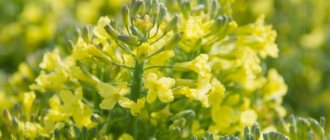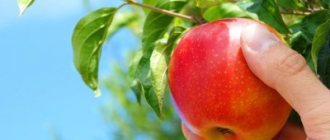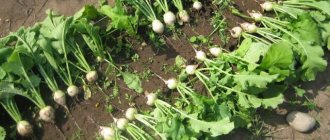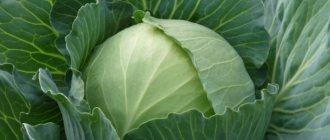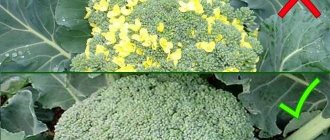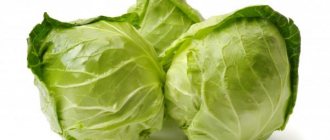Among the many varieties of cabbage, broccoli has firmly established itself as a hypoallergenic product that is extremely beneficial for adults and children. A gardener who wants to add to the variety of crops he grows should know exactly when to cut broccoli and what the standard storage rules are.
While white and red cabbage are kept fresh in storage for a very long time, the same cannot be said about broccoli inflorescences. The product is processed fresh in the shortest possible period of time or stored frozen.
How to Determine the Ripeness of Broccoli
For those who grow broccoli for personal use or for sale, it is important when to cut the crop. Time is of the essence.
Important! Overripe cabbage is not eaten, as it acquires an unpleasant bitterness and roughness; this cannot be corrected.
This variety of vegetables is so prized for its exceptional tenderness.
The following signs allow you to determine when broccoli is ripe:
- Head size. Its diameter is 10 cm or more. The easiest way to compare it is with the size of your palm. The size must be the same or larger.
- Color. With the onset of maturity, the shade changes from light to dark green. The buds remain tightly closed. The deadline comes when the buds bloom and the head of cabbage acquires a yellowish tint - all this indicates that the time to cut has passed. Fully blossomed cabbage immediately loses its delicate taste and is no longer suitable for cooking. Yellow color is a signal that it is too late to cut broccoli.
- From the emergence of seedlings to technical ripeness, an average of 2 months passes. A head of cabbage ready for cutting weighs at least 250 g.
- You can safely leave broccoli in the beds until the first frost, but not later. The dates will be different in each region, so varieties for planting are selected taking into account local climatic conditions.
Ripening time for broccoli
There is no clear time frame for when broccoli ripens. They vary depending on the planting method, climate, weather and care, although the recommendations on the seed packaging can serve as a guide: on average, this is 60-85 days from the moment the crop is planted.
There are early ripening varieties that ripen in 60 days. Among them, the varieties Commanche, Linda, and Tonus are very popular. Late-ripening species are ready in 75-80 days. Marathon and Lucky are favorites in this group.
Broccoli is a real storehouse of vitamins
Broccoli can be planted as seedlings, as well as seeds in open ground. Obviously, in the first case the harvest will be obtained faster.
Seedlings are planted when there are 4-5 leaves. Disembarkation time is the second half of May. With proper agricultural technology - timely watering, correct determination of the planting site, loosening and hilling - the cabbage will quickly begin to grow, and a month after planting the seedlings, the first heads of cabbage can be cut off.
Note! It is better to focus not on calendar dates, but to follow visually. If you just miss it, broccoli that is even a little overripe will ruin all your efforts to grow it.
In fact, every gardener himself answers the question about broccoli, when to pick it, since he knows better than anyone else the characteristics of the crop growing on his site. Experts give only general recommendations.
Harvest dates
The following signs common to all varieties help determine when it’s time to cut broccoli:
- The weight of the head of cabbage reached 500-700 g.
- The growing season specified by the planting material supplier (70-110 days) has ended.
- According to the weather forecast, frost is approaching. One night with sub-zero temperatures is enough to destroy all plantings. Therefore, there is no time to delay.
The heads that have just formed, but have not had time to either bloom or close tightly, have optimal taste. Then comes the time when it's time to cut the broccoli.
Advice! It is better to collect the heads of cabbage early than to miss the moment and let them grow old or freeze.
Steps
Part 1
How to cut the florets
- 1
Wash the broccoli thoroughly.
Take a head of broccoli and submerge it completely under running water. You can run your fingers over the inflorescences to get rid of dirt and insects that have accumulated there. After this, you can blot the vegetable with a dry towel.
- Broccoli should not be soaked in water to wash it.[5]
- 2
Separate the leaves from the broccoli head.
The leaves contain nutrients but are rarely used in traditional recipes. This will make the broccoli look more uniform in appearance, creating an aesthetically pleasing sliced product.[6][7]
- You can discard the leaves or use them in a salad served as a side dish with broccoli.[8]
- 3
Cut the inflorescences from the stems.
Do this using a knife or kitchen scissors, cutting them off as close to the trunk as possible. It is best to cut where the stem begins to branch into individual inflorescences.[9]
- The florets are part of the broccoli plant, which looks like a crown of tiny trees extending from a green stem.
Due to the thickness or position of the bud, you may have difficulty removing the bud well on the first try. But don't worry about this, as you can remove the extra stems as soon as you cut off all the inflorescences.
- 4
Cut off the inflorescences.
Start at the outer edge and work your way to the center junction of the florets. You can also separate the inflorescences from each other, but this will require making additional cuts to trim their ends.
- Ideally, you should cut off the buds about an inch before where the flowering part begins.
If you are going to cook the florets, try to get them to be the same size so that the cooking process occurs more evenly.
- Size won't matter if you're going to eat the florets raw, so you won't have to cut them all the same way.[10]
- 5
Continue cutting off the florets, working your way inside the broccoli head.
After trimming the inflorescences from the outside, you will be able to move along the stem, as a result of which further pruning will not take much of your time. Cut off absolutely all the inflorescences from the stem.[11]
- 6
Trim the stems of the inflorescences so that they are the same length.
Not only will this improve their appearance, but it will also ensure that the broccoli cooks evenly no matter what dish you're planning on making. You should leave about 1cm of stem near the florets.
- The florets will fall apart during cooking and processing if you cut off too much of the stem.[12]
- 7
If necessary, you can cut the florets into small pieces.
Large pieces of broccoli can be a great side dish for a meal, but it will cause the dish to lose its smoothness when mixed with other ingredients and when the pieces are fried too large. Take large broccoli florets and then:
- Cut the inflorescence in half using a knife or scissors. You can cut small pieces once and get the desired size. Or…
A large inflorescence must be cut into two parts. You can divide the largest pieces into four parts to make them the right size.
- The dish will cook evenly if you cut the florets into four equal pieces.[13]
Part 2
How to cut stems
- 1
Remove the inedible lower part of the stem.
The very bottom part will be too hard and will have a fibrous structure. Using a knife or scissors, cut about 2.5 to 5 centimeters from the stem. You can discard this part or use it as fertilizer.[14]
- 2
Using a paring knife, remove the tough skin.
The stem, as well as the inflorescences, contains many nutrients, and is sometimes even served in restaurants. However, first you must remove the tough outer skin.
- In restaurants, chopped broccoli stalks are often served under the name “coins”.[15][16]
- 3
Cut the stems into thin sticks.
Since the stem is tougher and denser than the florets, you will need more time to cook it. This is why you should cut the stems into thin strips, just like you usually do with carrots. Using a knife, cut the stems in half lengthwise. Place these halves together and re-cut them crosswise along the length, eventually dividing the stem into four parts.
- For a very thick stem, you can carry out this manipulation until you get pieces of the desired thickness.
This method of chopping vegetables is also called “julienne”. This is a well-known way of cutting vegetables, so you may want to learn more about it in one of our articles.
- You can also line the stems and use a knife or scissors to cut them into cubes.[17]
How to cut correctly
Proper cutting of heads of cabbage can significantly extend the fresh shelf life of cabbage. The rules are:
- The time to cut broccoli is early in the morning while there is dew on the grass. High humidity and coolness are necessary to ensure that vegetables do not overheat during transportation to the storage location and remain strong. If for some reason the morning cutting could not be completed, the work is postponed to the evening, when the evening dew has fallen.
- The central stem cannot be cut with a blunt instrument, only with a sharply sharpened knife. This way the tender head of cabbage remains intact, without dents or other damage. The cut is made strictly under the head of cabbage, being careful not to damage the lower leaves.
- You need to cut off the central head of cabbage first, and then the side ones when their time comes.
- The stem is the part of the plant that is eaten, so it is not thrown away. The cut used is a section from the central head of cabbage down 10 cm.
You should not uproot the bushes after cutting the central heads of cabbage. With proper care, new heads will grow from the axils of the lower leaves. Their sizes will be smaller, but the taste will be no worse. As they grow, new heads of cabbage must be cut off, trying not to be late. This is why the harvesting time for broccoli is quite extended.
Harvesting
Harvesting is a more complex process than growing cabbage itself, as it can be difficult to know when the heads are ripe. It is especially difficult for those who grow broccoli in the country, and because of this they cannot constantly monitor the growth of the vegetable.
Signs that determine whether cabbage is ready for cutting:
- head size. The diameter of a ripe head should not be less than 10 cm. If the cabbage has not reached this size, then it is too early to harvest it;
- the color should be intense green and the buds should be closed. If you see that they are blooming, and even more so turning yellow, then the cabbage is already overripe and it is high time to harvest it. An overripe vegetable becomes unsuitable for consumption due to its taste;
- head structure. They should be dense, but not very hard.
Important!
Full maturity of broccoli occurs at least 60 days after the first shoots. There is no point in starting the harvest early.
Be sure to monitor the temperature and do not wait for the first frost: cabbage can remain in the garden only until the temperature drops below 0 degrees. Broccoli is sensitive to low temperatures, and even one night of frost can destroy the entire crop.
It is recommended to start cutting early in the morning. During the day, when the sun becomes intense, the crop can quickly wilt. It is important to remember that the fruits should not be torn off, the stems sawed off, or pulled out, as this can damage the bush with its roots, but it can produce a second harvest.
The main thing is to carefully cut the cabbage; its safety depends on this. Using garden pruners (you can also use a regular sharp knife), make an oblique cut and separate the heads. It is important not to damage the leaves that are located below the stem.
After cutting the main head (if it is cut carefully and the bush is not damaged), active growth of side shoots will begin. New heads will form, and it is important not to miss the moment of their maturity so that they retain their taste. New heads of cabbage will be smaller than the main ones, but no less tasty.
Terms and conditions of storage of broccoli
Storage can be fresh or frozen.
Frozen
You can freeze broccoli correctly by performing a number of standard operations:
- Wash the cabbage in cold water to remove dust and soil.
- Remove leaves and woody parts of the stem.
- Divide the heads of cabbage into separate small inflorescences.
- Prepare the brine: 1 tbsp. l. salt per 1 liter of water.
- Soak the cabbage in brine for half an hour. This technique allows you to quickly get rid of all insects that may be hiding in the inflorescences.
- Rinse the broccoli again in clean water.
- Bring water to a boil in a wide saucepan.
- Immerse the inflorescences in boiling water and cook for 3 minutes.
- The removed heads of cabbage are immersed in ice water for 5 minutes.
- Let the cabbage drain in a colander.
- Place the broccoli in bags or containers and place in the freezer.
Cabbage prepared in this way can be stored for 12 months. At the right moment, just take out a bag or container and throw the inflorescences into boiling water to prepare the intended dish. Harvesting and storing broccoli in this way is the best option.
Fresh
You can save the harvest fresh, but for a much shorter period. It is advisable to consume a freshly cut head within 5 days. If you place it in a cold (up to + 4 0C) and humid environment, the storage period is a maximum of 15 days. If the inflorescences are damaged, they will deteriorate much faster.
It matters how exactly you send cabbage for fresh storage:
- A bouquet. The inflorescence is turned upside down and immersed in a container with cold water. The trick is that the inflorescence should be above the water and not touch it (you can use a lattice). The water is changed every day. In this way, freshness can be maintained in cabbage for 5-7 days.
- On paper. Kitchen paper towels will do. The inflorescences are wrapped in them and sprayed with cold water from a spray bottle. In this state they are placed in the refrigerator. This method is suitable for storing broccoli for 3 days.
- In the package. Only whole, undamaged inflorescences are placed in it. Make several punctures in the bag to ensure free air circulation. Store in the refrigerator for up to 5-7 days.
Factors that significantly reduce the shelf life of fresh cabbage:
- Temperature. It is best to keep vegetables in the refrigerator. At room temperature, the supply of nutrients in the inflorescences is sufficient for the ripening process to continue. This affects the taste in the most negative way.
- Humidity. Even in a refrigerator, the optimal humidity level is 90%. This prevents the cabbage from drying out, it will remain juicy and elastic.
- Careful handling. It is very easy to damage the delicate structure, and the taste of broccoli suffers greatly from this.
Based on this, it becomes clear why broccoli is sold in supermarkets mainly frozen or canned. Too short a fresh shelf life significantly limits the possibility of selling the product.
How to properly harvest broccoli
It is best to harvest fruits early in the morning. Under the scorching rays of the sun, the cabbage withers. Do not pull out the broccoli roots or tear the fruit. It is only necessary to cut off the head itself. To do this, step back about ten centimeters from the center of the fruit (head) and cut off the cabbage. Some manage to cut down the stem. There is no need to harm the plant in this way, because this bush can very soon bear a second harvest.
The optimal temperature for harvesting broccoli is no lower than minus two degrees. Take this fact into account and plan your time so that you have time to collect the fruits before the onset of frost. Since broccoli does not tolerate low temperatures, in just a few hours at -2 and below, cabbage will freeze quite quickly. After you cut off the head of broccoli, the side shoots will begin to grow, and very quickly. Be sure to keep track of the cutting time and the readiness of the cabbage for cutting.
From experience, a young broccoli shoot ripens in three days. In cloudy weather, ripening takes a little longer, it will take about a week. If cabbage is harvested at the right time, the crop will be stored much longer. It should be remembered that only late types of broccoli, which are harvested in the fall, are frozen and stored fresh. From the early ones, it is worth preparing food immediately, avoiding any storage. Try to be aware of the maturity of your cabbage planting and harvest on time! In this case, you will have a valuable, nutritious and dietary product on your table for a long time.
How to cook broccoli in a saucepan
In water
Place broccoli in boiling water. If desired, the water can be salted to taste. Reduce heat to medium.
Cooking time depends on what kind of cabbage you want:
- crispy broccoli - 1.5–2 minutes of cooking;
- slightly crispy broccoli - 3-4 minutes;
- soft broccoli - 6-8 minutes.
Place the finished cabbage in ice water for a minute. This will stop the cooking process and preserve the bright color of the vegetable.
For a couple
Boil water in a saucepan. Place a colander or a special steaming stand on top. It should not touch the water.
Place the broccoli in a colander or rack and cover with a lid. Cook the cabbage over medium heat for 5-10 minutes. The longer it sits over steam, the softer it will become.
How to tell if broccoli is ripe
In Europe, broccoli became famous at the beginning of the 16th century, although the Greeks and Romans had been eating it for 2 thousand years. Catherine de Medici introduced broccoli into French cuisine. Then broccoli appeared in Europe and America. Not so long ago, her fans appeared in Russia.
Broccoli is one of the subspecies of cauliflower, but differs in the shape and structure of the head. Translated from Italian, “brocco” means “escape”, “branch”. A broccoli stem is a bunch of branches that have a group of small green or purple buds at the end. The head of broccoli should be cut off before the buds bloom. Broccoli does not like heat and dryness, grows well in damp climates, and can tolerate light frosts. It has no contraindications for use.
Types of broccoli
There are more than 200 varieties of broccoli in the world. Mostly Brassica oleracea or Brassica italica is grown. The first type is also called calabrese - a thick head of cabbage with a round head of white, green, purple color. The inflorescences are closely adjacent to each other. In the West, they produce a cone-shaped head in yellow, orange, and brown shades.
Another type is called asparagus or Italian cabbage. It is a bunch of thin stems with small inflorescences at the end. The stems of this type of broccoli are eaten; they taste similar to asparagus.
To preserve the healthfulness of broccoli, I process it minimally: blanch or steam it.
Why broccoli is good for your health
Thanks to its beneficial properties, this vegetable is loved all over the world. Broccoli is the “miracle cabbage” that helps prevent cancer and strengthen the immune system. It combines the most beneficial vitamins for the body. Contains substances such as beta-carotene, phosphorus and potassium, iron and zinc, calcium and magnesium, sulfur and manganese. As well as protein, fiber and essential amino acids necessary for every person.
And also broccoli:
- inhibits the growth of fungi and bacteria;
- prevents thyroid diseases;
- helps fight atherosclerosis and aging;
- reduces the risk of breast diseases;
- treats stomach ulcers, urolithiasis, prostate and others;
- indicated for cataracts, stroke, nervous diseases;
- very useful for pregnant women and children;
- has many other useful properties.
This cabbage is almost irreplaceable in the diet of any person. If you eat 300g of it every day, you can protect yourself from cancer and other complex diseases. 100 g of broccoli contains 150% of the daily requirement of proteins, fats, vitamins and fiber required by humans. It is low in calories, as 90% is water.
How to grow broccoli
Russia's damp and cool climate is well suited for growing broccoli. She needs temperatures from 160 to 250C, but can live down to -70C. Broccoli prefers neutral or slightly alkaline soil.
If you plan to grow broccoli, you need to prepare in the fall. First you need to put organic (manure or compass) and mineral fertilizers (potassium chloride, superphosphate) into the ground. And in the spring, just before planting cabbage, you need to feed the soil with nitrogen fertilizers or ammonium nitrate. Subsequent cultivation of the soil is no different from growing ordinary cabbage. It is necessary to regularly weed, water and hill up the soil, which stimulates the growth of additional roots.
To grow an early harvest, cabbage is grown by planting seedlings. It should grow for 35-45 days. Then, in early May, the seedlings are planted in the garden. This can be done several times until the end of June. Two weeks after planting, they begin to feed with organic fertilizers. For 10 liters of water you need to dilute 0.5 liters of mullein with 1 teaspoon of urea. 5 liters of fertilizer are consumed per 1 m2. They are carried out every 12-15 days. The second feeding may be different: add 2 tablespoons of nitroammophoska to 10 liters of water. Broccoli will be ready for cutting from mid-July to the end of autumn.
You need to make sure that the heads do not have time to bloom, since after flowering, pods with seeds are formed and the broccoli becomes unsuitable for food. The head is cut off along with part of the stem. To prevent the cabbage from wilting longer, cut off the head in the morning when there is dew. Then side branches grow, which bring additional harvest, but with smaller heads.
Broccoli can be replanted in the same area no earlier than after 4 years. This plant requires almost no chemical treatment and suffers little illness.
Broccoli is undemanding to the weather and tolerates our climate well. It is useful for eating, its cultivation is not difficult, and the harvest can be obtained in several stages. It might be worth trying to plant it for your needs. And given that there are few offers on the market, you can start selling and growing broccoli to order.
How to properly cut broccoli
Most broccoli dishes call for florets of varying sizes. Knowing how to properly cut vegetables will allow you to prepare meals accordingly so as not to waste the edible parts. To start chopping broccoli, follow this procedure:
- Cut off and discard the very bottom of the stem as it is usually tough.
- Then trim off the small blossoms to make the stems easier to peel.
- Using a small knife, remove the outer layer of the stem to expose the tender green flesh underneath.
- Separate the flowers and stem.
Now you can cut vegetables in any way convenient for you. For smaller cuts, make slices one-quarter to one-half inch thick. For larger pieces, cut the stems into 1 - 3 inch segments.
Through this process, you will be able to include the stem in your dishes, as it is also an edible part of the plant. This allows you to get the most out of your vegetables and get value for your money.
Broccoli: Which part can you eat?
The head of cabbage consists of a stem, leaves and inflorescences. They are all edible, but not all are used. Usually the buds with a small branch are cut from the dense stem and cooked separately. They taste better and require less hassle.
The twigs contain more nutrients than the inflorescences. If you come across stems that are too hard, remove the skin from them and leave the tender light core. It should be boiled and then fried or mixed into a stew, but the healthiest thing is to grate it and make a salad.
The twigs contain more nutrients than the inflorescences. If you come across stems that are too hard, remove the skin from them and leave the tender light core. It should be boiled and then fried or mixed into a stew, but the healthiest thing is to grate it and make a salad.
I throw away the leaves, although many sources report their nutritional value. Their taste is harsh and, in my opinion, not suitable for eating. I tried pouring boiling water over them, boiling them, and in the end I came to the conclusion that it was better not to waste time on trifles.
If you want to experiment, then choose heads of cabbage with elastic leaves of rich color without damage. Maybe your experience will be better than mine.
When to remove broccoli from the garden?
The main rule for harvesting broccoli is to prevent it from getting overripe. Indeed, in this case, all efforts to grow will be in vain. Broccoli is harvested when the flowers have not yet opened, that is, before they acquire the characteristic yellow color, since in this case the taste of the cabbage is completely lost.
Signs of head maturation
Mature heads of classic broccoli varieties are dark green in color. Some modern varieties may have a light yellow, white, glaucous or purple hue. Other signs of head maturation include the following:
- large buds on the top and smaller ones on the sides of the inflorescences;
- dense, but not very hard inflorescences;
- large sizes - at least 10 cm in diameter;
- weight not less than 250 grams.
Ripe heads of classic broccoli varieties
When the calendar ripening period approaches, it is important to carefully inspect the cabbage every day to prevent the buds from opening. Before flowering, the dense inflorescence breaks up into several separate ones, so during this period you must hurry with cleaning.
